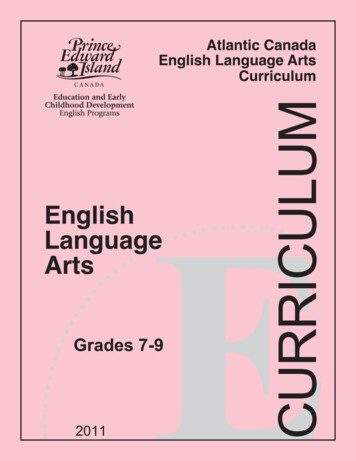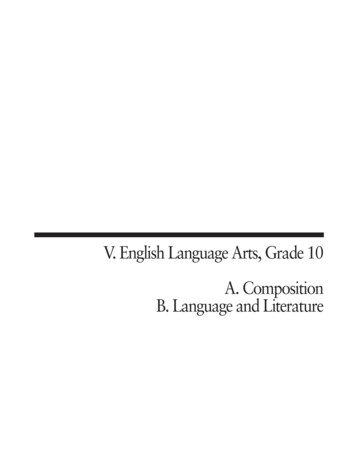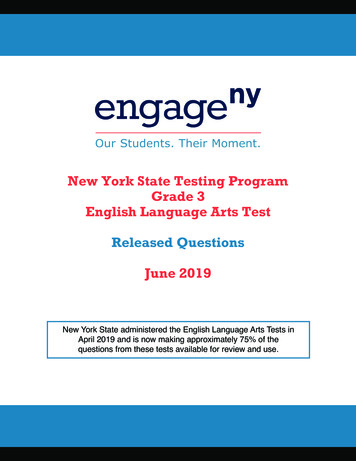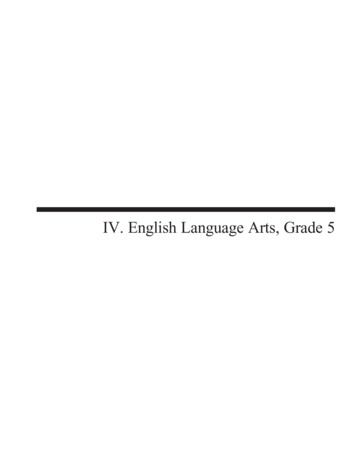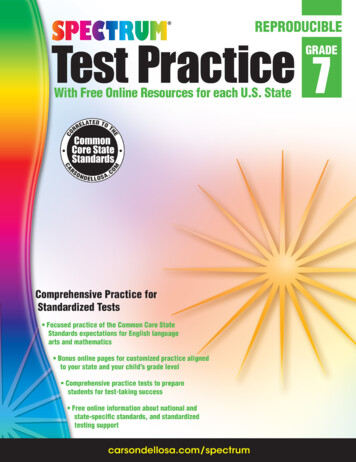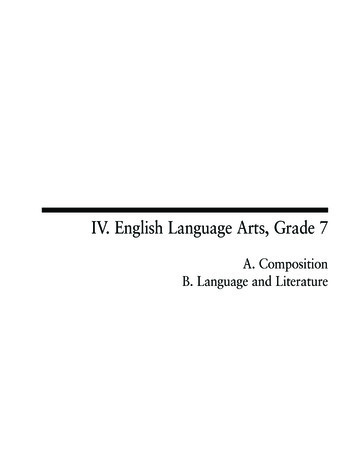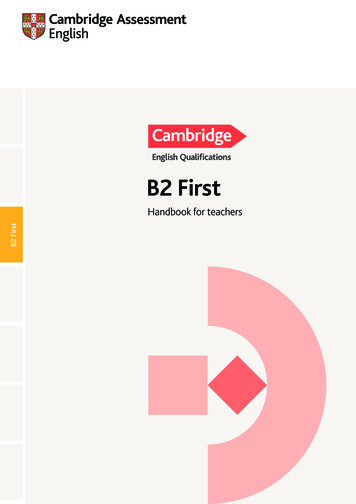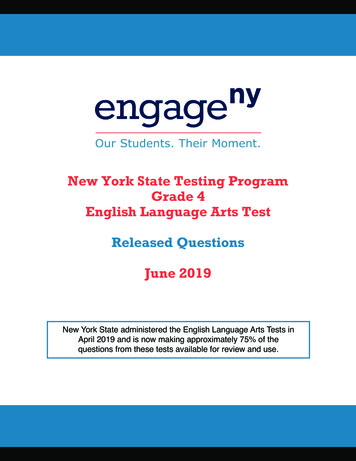
Transcription
New York State Testing ProgramGrade 4English Language Arts TestReleased QuestionsJune 2019New York State administered the English Language Arts Tests inApril 2019 and is now making approximately 75% of thequestions from these tests available for review and use.
THE STATE EDUCATION DEPARTMENT / THE UNIVERSITY OF THE STATE OF NEW YORK / ALBANY, NY 12234New York State Testing ProgramGrades 3–8 English Language ArtsReleased Questions from 2019 ExamsBackgroundIn 2013, New York State began administering tests designed to assess student performance in accordancewith the instructional shifts and rigor demanded by the new New York State P-12 Learning Standards inEnglish Language Arts (ELA). To help in this transition to new assessments, the New York State EducationDepartment (SED) has been releasing an increasing number of test questions from the tests that wereadministered to students across the State in the spring. This year, SED is again releasing large portions ofthe 2019 NYS Grades 3–8 English Language Arts and Mathematics test materials for review, discussion, anduse.For 2019, included in these released materials are at least 75 percent of the test questions that appearedon the 2019 tests (including all constructed-response questions) that counted toward students’ scores.Additionally, SED is providing information about the released passages; the associated text complexity foreach passage; and a map that details what learning standards each released question measures and thecorrect response to each question. These released materials will help students, families, educators, and thepublic better understand the tests and the New York State Education Department’s expectations forstudents.Understanding ELA QuestionsMultiple-Choice QuestionsMultiple-choice questions are designed to assess the New York State P-12 Learning Standards in EnglishLanguage Arts. These questions ask students to analyze different aspects of a given text, including centralidea, style elements, character and plot development, and vocabulary. Almost all questions, includingvocabulary questions, will be answered correctly only if the student comprehends and makes use of thewhole passage.For multiple-choice questions, students select the correct response from four answer choices. Multiplechoice questions assess reading standards in a variety of ways. Some ask students to analyze aspects of textor vocabulary. Many questions require students to combine skills. For example, questions may ask studentsto identify a segment of text that best supports the central idea. To answer these questions correctly, astudent must first comprehend the central idea and then show understanding of how that idea is supported.Questions tend to require more than rote recall or identification.Short-Response QuestionsShort-response questions are designed to assess New York State P-12 Reading and Language Standards.These are single questions in which a student uses textual evidence to support his or her answer to aninferential question. These questions ask the student to make an inference (a claim, position, or conclusion)
based on his or her analysis of the passage, and then provide two pieces of text-based evidence to supporthis or her answer.The purpose of the short-response questions is to assess a student’s ability to comprehend and analyzetext. In responding to these questions, students are expected to write in complete sentences. Responsesrequire no more than three complete sentences. The rubric used for evaluating short-response questionscan be found in the grade-level Educator Guides at sh-language-arts-and-mathematics.Extended-Response QuestionsExtended-response questions are designed to measure a student’s ability to write from sources. Questionsthat measure Writing from Sources prompt students to communicate a clear and coherent analysis of oneor two texts. The comprehension and analysis required by each extended response is directly related tograde-specific reading standards. Student responses are evaluated on the degree to which they meet gradelevel writing and language expectations. This evaluation is made by using a rubric that incorporates thedemands of grade-specific New York State P-12 Reading and Language standards.The integrated nature of the standards for ELA and literacy requires that students are evaluated across thestrands (Reading, Writing, and Language) with longer pieces of writing, such as those prompted by theextended-response questions. The rubric used for evaluating extended-response questions can be found inthe grade-level Educator Guides at ish-languagearts-and-mathematics.New York State P-12 Learning Standards AlignmentThe alignment(s) to the New York State P-12 Learning Standards for English Language Arts is/are intendedto identify the analytic skills necessary to successfully answer each question. However, some questionsmeasure proficiencies described in multiple standards, including writing and additional reading andlanguage standards. For example, two-point and four-point constructed-response questions requirestudents to first conduct the analyses described in the mapped standard and then produce writtenresponses that are rated based on writing standards. To gain greater insight into the measurement focusfor constructed-response questions, please refer to the rubrics.These Released Questions Do Not Comprise a “Mini Test”To ensure future valid and reliable tests, some content must remain secure for possible use on futureexams. As such, this document is not intended to be representative of the entire test, to show howoperational tests look, or to provide information about how teachers should administer the test; rather, itspurpose is to provide an overview of how the test reflects the demands of the New York State P-12 LearningStandards.The released questions do not represent the full spectrum of the standards assessed on the State tests, nordo they represent the full spectrum of how the standards should be taught and assessed in the classroom.It should not be assumed that a particular standard will be measured by an identical question in futureassessments. Specific criteria for writing test questions, as well as additional assessment information, areavailable at http://www.engageny.org/common-core-assessments.
2019 Grade 4 ELA Test Text Complexity Metrics forReleased Questions Available on EngageNYSelecting high‐quality, grade‐appropriate passages requires both objective textcomplexity metrics and expert judgment. For the Grades 3–8 assessments based on theNew York State P‐12 Learning Standards for English Language Arts, both quantitativeand qualitative rubrics are used to determine the complexity of the texts and theirappropriate placement within a grade‐level ELA exam.Quantitative measures of text complexity are used to measure aspects of textcomplexity that are difficult for a human reader to evaluate when examining a text.These aspects include word frequency, word length, sentence length, and text cohesion.These aspects are efficiently measured by computer programs. While quantitative textcomplexity metrics are a helpful start, they are not definitive.Qualitative measures are a crucial complement to quantitative measures. Usingqualitative measures of text complexity involves making an informed decision about thedifficulty of a text in terms of one or more factors discernible to a human readerapplying trained judgment to the task. To qualitatively determine the complexity of atext, educators use a rubric composed of five factors; four of these factors are requiredand one factor is optional. The required criteria are: meaning, text structure, languagefeatures, and knowledge demands. The optional factor, graphics, is used only if agraphic appears in the text.To make the final determination as to whether a text is at grade‐level and thusappropriate to be included on a Grades 3–8 assessment, New York State uses a two‐stepreview process, which is an industry best‐practice. First, all prospective passagesundergo quantitative text complexity analysis using three text complexity measures. Ifat least two of the three measures suggest that the passage is grade‐appropriate, thepassage then moves to the second step, which is the qualitative review using the text‐complexity rubrics. Only passages that are determined appropriate by at least two ofthree quantitative measures of complexity and are determined appropriate by thequalitative measure of complexity are deemed appropriate for use on the exam.For more information about text selection, complexity, and the review process pleaserefer xt‐complexity‐grades‐9‐12
Around the WorldMouse Deer and the TigersThe Day I Rescued Einstein's CompassMeet Hannah Wynne: Teen StorytellerReaching for the Top6.72.53.676Degrees ofReading Power*810L510L560L760L790LReading ncaidPassage TitleLexileText Complexity Metrics for 2019 Grade 4 opriateAppropriateAppropriateAppropriate* Depending on when the passage was selected, either the Reading Maturity Metric or Degrees of Reading Power wasused as the third quantitative metric.New York State 2019 Quantitative Text Complexity Chart for Assessment and CurriculumTo determine if a text’s quantitative complexity is at the appropriate grade level, NewYork State uses the table below. In cases where a text is excerpted from a large work,only the complexity of the excerpt that students see on the test is measured, not thelarge work, so it is possible that the complexity of a book might be above or below gradelevel, but the text used on the assessment is at grade level. Because the measurementof text complexity is inexact, quantitative measures of complexity are defined by gradeband rather than by individual grade level and then paired with the qualitative review byan �10th11th–12thATOS2.75 – 5.144.97 – 7.037.00 – 9.989.67 – 12.0111.20 – 14.10Degrees ofReadingPower42 – 5452 – 6057 – 6762 – 7267 – 74Source: Student Achievement PartnersFlesch-Kincaid1.98 – 5.344.51 – 7.736.51 – 10.348.32 – 12.1210.34 – 14.20The LexileFramework420 – 820740 – 1010925 – 11851050 – 13351185 – 1385ReadingMaturity3.53 – 6.135.42 – 7.927.04 – 9.578.41 – 10.819.57 – 12.00SourceRater0.05 – 2.480.84 – 5.754.11 – 10.669.02 – 13.9312.30 – 14.50
RELEASED QUESTIONS
RELEASED QUESTIONS
“The Day I Rescued Einstein’s Compass” by Shulamith Levey Oppenheim. Copyright 2003 by Cricket Media. Published in “CelebrateCricket” by Cricket Books. Used with permission via Copyright Clearance Center.“Meet Hannah Wynne: Teen Storyteller” by Kathiann M. Kowalski, AppleSeeds, February 2009, Vol. 11, Issue 5. Copyright 2009 byCricket Media. Used with permission of Carus Publishing Company via Copyright Clearance Center.“Reaching for the Top” by Kassandra Radomski, AppleSeeds, July/August 2012, Vol. 14, Issue 9. Copyright 2012 by Cricket Media. Usedwith permission of Carus Publishing Company via Copyright Clearance Center.Developed and published under contract with the New York State Education Department by Questar Assessment Inc., 5550 Upper 147thStreet West, Minneapolis, MN 55124. Copyright 2019 by the New York State Education Department.Session 2
Session 2TIPS FOR TAKING THE TESTHere are some suggestions to help you do your best: Be sure to read all the directions carefully. ost questions will make sense only when you read the whole passage. You may readMthe passage more than once to answer a question. When a question includes a quotationfrom a passage, be sure to keep in mind what you learned from reading the wholepassage. You may need to review both the quotation and the passage in order to answerthe question correctly. Read each question carefully and think about the answer before writing your response. In writing your responses, be sure to– clearly organize your writing and express what you have learned;– accurately and completely answer the questions being asked;– support your responses with examples or details from the text; and– write in complete sentences using correct spelling, grammar, capitalization,and punctuation. F or the last question in this test book, you may plan your writing on the Planning Pageprovided, but do NOT write your final answer on this Planning Page. Writing on thisPlanning Page will NOT count toward your final score. Write your final answer on thelined response pages provided.Session 2Page 1
Read this story. Then answer questions 25 through 27. eo is in a boat named “Fleet Felix” with Albert Einstein, a very famousscientist. Einstein speaks first. e Day I Rescued Einstein’s Compassby Shulamith Levey Oppenheim1“When I was five years old, I was quite ill. I had to stay in bed for manydays. My father gave me this compass.” He peered at me. “You know what acompass is, of course?” I nodded. “Good.” He continued, “It was the firstcompass I had ever seen. ere was the needle, under glass, all alone,pointing north no matter which way I turned the compass.”2I took a deep breath. “Because the needle is magnetic, and there is amagnet at the North Pole that attracts the needle.”3My sailing partner raised his bushy eyebrows. “Nearly correct. ere aretwo magnetic poles, north and south. So far away. And there, on the palmof my hand, was my compass, always pointing north! For me, it was thegreatest mystery I could imagine. And so I decided, then and there, that Iwould learn all about the forces in the universe that we cannot see. For Icertainly could not . . .”4At that moment a large motorboat zoomed past us, stirring up the waterinto high waves. One of them hit Fleet Felix smack against the side,knocking the compass from the professor’s hand, right into the water!5He stared at his empty palm. “ e compass, eo. It is gone!Overboard?” Suddenly there was so much sadness in his eyes. “I shouldhate to lose it. And I cannot swim very well . . . and my eyesight is notgood . . .” His voice trailed off, and he was looking far into space.6But I could swim! In a split second I dropped anchor into the water tokeep the boat in place. I pulled off my life jacket. e waves had quieteddown now. e compass would float. If I were lucky.GO ONPage 2Session 2
78I jumped into the water. en I started swimming farther away from the boat. Under and underand round and round. No compass. I had to find it! Herr Professor Einsteinmight be the most famous man alive right now, but he was once five yearsold, and his father had given him a compass that he had treasured all theseyears. I thought about the splendid binoculars my parents had given meand how I would feel if I lost them.Herr a German word for “Mr.”9I made another dive under the boat. As I came up for air, I feltsomething ever so gently hit my cheek. It was the compass, bobbingalongside Fleet Felix, just waiting to be rescued! Clutching it in my le hand, I grabbed hold of the boat with my right. Professor Einstein’s eyeswere closed.10He opened his eyes. “So,” he said with a smile, “this is why I became aphysicist,” continuing as if nothing had happened. “As you know, aphysicist studies the forces in nature that we cannot know directly, only weknow they are there from what we observe, like the compass needle or . . . ,”he paused.11“Or gravity?” I offered, a bit tentatively.12“Bravo, young man. Or gravity. All these forces keep our planet runningquite smoothly most of the time. And thank you, dear eo. For me, youare the most famous boy alive!”13His eyes were merry again. I was still trying to catch my breath, but Ihad to ask another question. “Would you say it is because of the compassthat you are now the most famous man alive?”GO ONSession 2Page 3
25In the story, how does Einstein feel about the compass his father gave him? Use twodetails from the story to support your response.GO ONSession 2Page 5
26What does paragraph 6 show about eo’s point of view? Use two details from the storyto support your response.GO ONPage 6Session 2
27Read this sentence from paragraph 8 of the story.I thought about the splendid binoculars my parents had given me and how Iwould feel if I lost them.How does this sentence support a theme of the story? Use two details from the story tosupport your response.GO ONSession 2Page 7
Read this article. Then answer questions 28 and 29.Meet Hannah Wynne: Teen Storytellerby Kathiann M. Kowalski1Like most kids, Hannah Wynne has always loved hearing stories. ButHannah doesn’t just listen. At age 18, Hannah is already a professionalstoryteller.2As a little girl, Hannah told stories to family members in Valley City,Ohio. Later, she shared stories with friends during school recess. “I lovedgiving oral book reports,” adds Hannah. O en Hannah dressed as a bookcharacter to tell her books’ stories to the class.3When Hannah was 15, a professional storyteller named Janelle Reardonperformed at a cousin’s birthday party. Hannah knew then that she wantedto become a storyteller, too. Soon a erward, Janelle began coachingHannah. en Hannah began performing.4“All my stories right now are personal stories,” says Hannah. “Most ofthem are funny.” Most of Hannah’s stories are about eight minutes long.And most come from things that happened when Hannah was around6 years old. But the stories aren’t just memories, she says. “Our lives aren’tlike movies or books. We’re not moving toward one goal.”5Instead, starting with real events, Hannah makes up stories with abeginning, middle, and end. Even her funny stories o en have a lesson. In“ e Revenge of Dr. Seuss,” young Hannah wanted to hear Fox in Socksover and over. But her mom was tired of that book. She had already read itmany times for Hannah’s older brother and sisters.6Hannah told that story at the National Youth Storytelling Showcase inPigeon Forge, Tennessee, in 2007. With it, she won the title of High SchoolDivision Torchbearer. Hannah also met other young storytellers fromGO ONPage 8Session 2
across the nation. “ e oldest was 18, and the youngest was 7 that year,”says Hannah. “Everyone was fantastic. And I learned so much fromeveryone.”7Today, Hannah tells stories at schools, libraries, recreation centers, andstorytelling festivals. A er college, she hopes to be a professional writerand continue storytelling.8Hannah especially loves when people laugh along with her. Her storieso en remind people about events in their own lives. At its heart,storytelling is about sharing a story or an experience and connecting withthe listeners. “ e best way to tell people what storytelling is,” Hannahsays, “is to tell them a story.”GO ONSession 2Page 9
28How do paragraphs 7 and 8 support the main idea of the article “Meet Hannah Wynne:Teen Storyteller”? Use two details from the article to support your response.GO ONPage 10Session 2
29According to the article “Meet Hannah Wynne: Teen Storyteller,” what kind of person isHannah? Use two details from the article to support your response.GO ONSession 2Page 11
Read this article. Then answer questions 30 and 31.Reaching for the Topby Kassandra Radomski1For the past six years, Jordan Romero has been chasing a dream. atdream has taken him to the top of the world’s highest mountains. edream came true when the California teenager stepped onto the peak ofMount Vinson Massif in Antarctica.2On that day—December 24, 2011—Jordan became the youngest personto have climbed the tallest mountain on each of the seven continents. ese mountains are known as the “seven summits.” (A summit or peak isthe highest point of a mountain.)3It all began when Jordan was 9 years old. He became fascinated by aschool mural that showed the seven summits. Jordan had never climbed amountain before. But he told his dad that he wanted to climb them ALL!4His dad, an experienced mountaineer, was very supportive. In fact,Jordan’s dad and stepmom trained him in top-level mountaineering andclimbed every mountain with him. As part of “Team Jordan,” they alsobecame the first family to climb the seven summits together.5Training to climb the highest mountains in the world involves a lot ofhard work. But Jordan has always been very physically active—it’s just theway he lives. Still, there were times when he thought, “Yeah, I want to bedone.”6But he refused to give up. When others thought he was too young toclimb Mount Everest, the world’s highest mountain, he just became moredetermined. He recalls thinking at the time, “All you naysayers, I’ll showyou.” He sure did. When he was 13, he became the youngest person to scaleMount Everest.GO ONPage 12Session 2
78He encourages kids to “find your Everest.” at doesn’t mean he wantseveryone to start mountain climbing. He means find something you lovedoing and set goals to accomplish it.“Anything is possible,” Jordan says.GO ONSession 2Page 13
30In paragraph 6 of the article, what does Jordan mean when he says “All you naysayers,I’ll show you”? Use two details from the article to support your response.GO ONPage 14Session 2
DO NOT WRITETHIS PAGE PURPOSELYLEFT BLANKGO ONSession 2Page 15
31In “Meet Hannah Wynne: Teen Storyteller” and “Reaching for the Top,” the authors tellhow Hannah Wynne and Jordan Romero became successful when they were veryyoung. What is different about how adults are mentioned in the articles? Do the articlesshow if adults helped them to become successful? Use details from both articles tosupport your response.In your response, be sure toexplain what is different about how adults are mentioned in the articlesexplain whether the articles show if adults helped them to become successfuluse details from both articles to support your responseGO ONSession 2Page 17
STOPPage 18Session 2
Grade 42019English Language Arts TestSession 2April 2 – 4, 2019
THE STATE EDUCATION DEPARTMENTTHE UNIVERSITY OF THE STATE OF NEW YORK / ALBANY, NY 122342019 English Language Arts Tests Map to the StandardsGrade 4QuestionSession 1131415161718192021222324Session 225262728293031TypeMultiple ChoiceMultiple ChoiceMultiple ChoiceMultiple ChoiceMultiple ChoiceMultiple ChoiceMultiple ChoiceMultiple ChoiceMultiple ChoiceMultiple ChoiceMultiple ChoiceMultiple ChoiceConstructed ResponseConstructed ResponseConstructed ResponseConstructed ResponseConstructed ResponseConstructed ResponseConstructed ResponseKeyBBAACDDBBBCAPoints StandardMultiple Choice CSS.ELA-Literacy.RL.4.3Reading Standards for Informational TextReading Standards for Informational TextReading Standards for Informational TextReading Standards for Informational TextReading Standards for Informational TextReading Standards for Informational TextLanguage StandardsReading Standards for LiteratureReading Standards for LiteratureReading Standards for LiteratureReading Standards for LiteratureReading Standards for ELA-Literacy.RI.4.9Reading Standards for LiteratureReading Standards for LiteratureReading Standards for LiteratureReading Standards for Informational TextReading Standards for Informational TextReading Standards for Informational TextReading Standards for Informational TextWriting to SourcesWriting to SourcesWriting to SourcesWriting to SourcesWriting to SourcesWriting to SourcesWriting to SourcesSecondary Standard(s)*This item map is intended to identify the primary analytic skills necessary to successfully answer each question on the 2019 operational ELA test. However, each constructed-responsequestion measures proficiencies described in multiple standards, including writing and additional reading and language standards. For example, two-point and four-point constructedresponse questions require students to first conduct the analyses described in the mapped standard and then produce written responses that are rated based on writing standards. Togain greater insight into the measurement focus for constructed-response questions, please refer to the rubrics shown in the Educator Guides.Percentage of StudentsWho Answered Correctly(P-Value)Constructed Response Questions:P-Value(Average PointsEarnedAverage Total 80.70.650.490.640.680.650.39
Grade 4 English Language Arts Test Released Questions June 2019 . the 2019 NYS Grades 3–8 English Language Arts and Mathematics test materials for review, discussion, and use. . do they represent the ful


